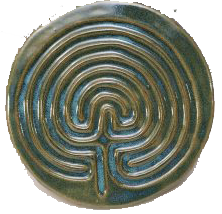
“In a labyrinth, one does not lose oneself
In a labyrinth, one finds oneself”
– Hermann Kern, Through the Labyrinth
A labyrinth resembles a maze, but its distinguishing feature is a single path, which is in full view. Once you set your foot upon the path, you can only reach your destination, the center. But not by going forward, not by clinging to your sense of north and south, right and left. No, your path approaches the center, then maddeningly veers away, taking you on a vast sweep of the outer edges, back to the inner circuits, until finally, you reach your goal, the sweet calm of the labyrinth’s heart. After your time there, your way out is equally unambiguous.
Labyrinths have been found all over the world—Russia, Great Britain, Europe, Crete, China, Egypt, India, Turkey, Israel, Mexico, North America—dating from ca. 1400 BCE. Many of the patterns are based on nature’s spirals. From ancient times, the path through the labyrinth has been used ritually to represent the soul’s journey through life to death, the young person’s journey into adulthood, the pilgrim’s symbolic journey to Jerusalem. In our time, we walk the labyrinth to represent inner journeys—to wholeness, to the reconciliation of the inner and outer selves, to self-awareness, to healing. The temporary loss of linear time and sense of direction can lead to your particular spiritual path.
From ancient times, the path through the labyrinth has been used ritually to represent the soul’s journey. In our time, we walk the labyrinth to represent inner journeys—to wholeness, to the reconciliation of the inner and outer selves, to self-awareness, to healing.